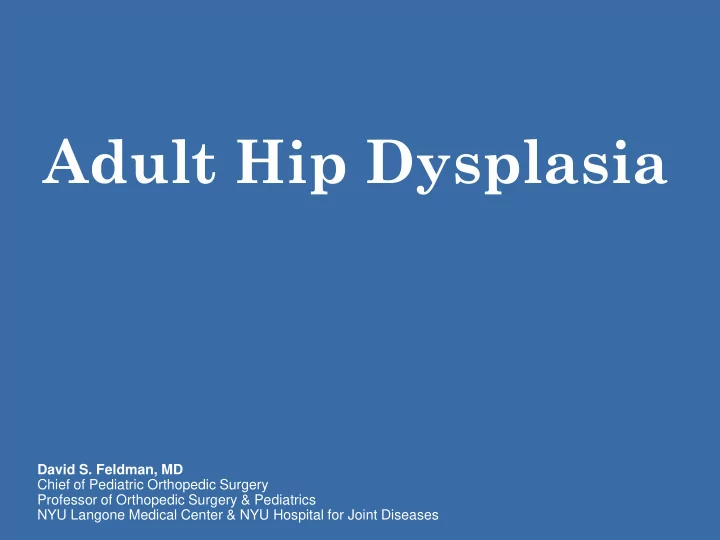

Adult Hip Dysplasia David S. Feldman, MD Chief of Pediatric Orthopedic Surgery Professor of Orthopedic Surgery & Pediatrics NYU Langone Medical Center & NYU Hospital for Joint Diseases
Overview Adult hip dysplasia describes a condition where the hip’s ball (femoral head) and socket (acetabulum) are misaligned. The condition is common in children but is also found in adolescents and adults who have had no history of problems in childhood. Treatment options include temporizing with medication and/or physical therapy but surgery is often required to fix the problem.
Description Hip dysplasia occurs in adults when the femoral head or the acetabulum has not developed fully or correctly. It becomes difficult for the femoral head to remain properly positioned within the acetabulum if the hip has a poorly angled or rotated femoral head/neck or shallow acetabulum.
A severe or prolonged misalignment of the hip’s ball and socket results in increased friction which causes the joint’s cartilage to wear out quickly leading to cartilage (labral) tears and eventually osteoarthritis.
Symptoms Hip dysplasia ranges from mild to severe and can affect one or both hips. A dysplastic hip socket typically causes discomfort and pain beginning in late adolescence and gradually becomes worse over time. A shallow acetabulum may develop during infancy but may not be evident until after puberty and may not cause pain until the teen years or later.
Common symptoms of hip dysplasia include: Abnormal positioning or turning of the legs Decreased range of motion on the side where the hip is partially (subluxed) or fully dislocated The leg may appear shorter on the side where the hip is partially (subluxed) or fully dislocated A limp if one hip joint is affected or waddle if both hip joints are affected. However, an abnormal gait might be more difficult to detect if both hips are dislocated. Undiagnosed hip dysplasia may result in osteoarthritis
Cause While hip dysplasia occurs in adults as a result of abnormal development of the hip during the growing years, the exact cause of this development is unknown.
Diagnosis Methods Given that early detection is a vital factor in treatment in infants, screenings for hip dysplasia should take place during all postnatal exams and continue throughout infancy. Detection remains equally important during adolescence and adulthood which necessitates immediate evaluation of and care for any persistent hip pain.
Following the onset of hip pain or discomfort in an adult or adolescent, a physical exam should be performed to assess the hip’s range of motion.
In a case of hip dysplasia that is mild or in the early stages, the hip may have a mostly normal range of motion. However, discomfort or stiffness in the hip may occur when attempts are made to move the leg away from the body (abduction) or from a bent 90 degree to a straight extended position.
As the condition worsens, the patient may develop a limp, leg lengths may appear unequal, and it may become difficult to rotate the thigh towards or away from the body.
X-rays and MRI scans should be ordered to clarify and confirm the results of the physical exams. X-rays are typically used to assess the alignment of the acetabulum and femoral head while MRI scans are used to assess the hip’s soft tissue and cartilage (labrum).
TREATMENT
The aim of treatment is to keep the femoral head in good contact with the acetabulum. The specific course of treatment for each patient should be determined on an individualized basis with both the age of the patient and severity of their particular case taken into consideration.
Non-Surgical Treatment Early or mild hip dysplasia may be treated non-surgically while the patient continues to be observed for changes in the progression of their condition. Medication and steroid injections are used to relieve pain and inflammation in the hip. A cane can be used to temporarily decrease force on the hip joint while physical therapy strengthens the muscles around the hip and increases the joint’s strength and flexibility.
Surgical Treatment
Hip Arthroscopy In many cases of hip dysplasia, there is torn cartilage (labrum) that needs to be addressed prior to the undertaking of deepening the socket. In a minimally invasive procedure, a small camera is inserted into the body (arthroscopy) and used to view the hip socket which allows minor repairs to be made to the labrum. When used alone, the procedure will typically result in repeated tearing of the labrum. As a result, hip arthroscopies are most effective when used in combination with an osteotomy as outlined below.
Periacetabular (Ganz) Osteotomy Periacetabular (Ganz) osteotomies are the most common and effective method for deepening and repositioning the hip socket beyond the age of skeletal maturity (age 15 in boys and 13 in girls). A periacetabular osteotomy is a surgical procedure where the hip socket is freed and reset. Screws are utilized to hold the socket in the correct position and proper alignment. The acetabulum is surgically separated from the rest of the pelvis and moved into the proper position over the femoral head. Over the last 18 years and hundreds of hips, we have had outstanding results in utilizing this procedure for teenagers and adults with acetabular hip dysplasia.
Femoral Osteotomy Less commonly, hip dysplasia requires the femur to be realigned into the cup. This is performed by cutting the bone, changing the rotation or angulation of the femur, and putting a plate and screws in place to hold the bone until it heals in position.
Hip Replacement Hip replacement should be a last resort reserved for cases of adult hip dysplasia where the severity of the condition renders all other hip preserving procedures insufficient.
David S. Feldman, MD Pediatric Orthopedic Surgeon www.davidsfeldmanmd.com
Recommend
More recommend